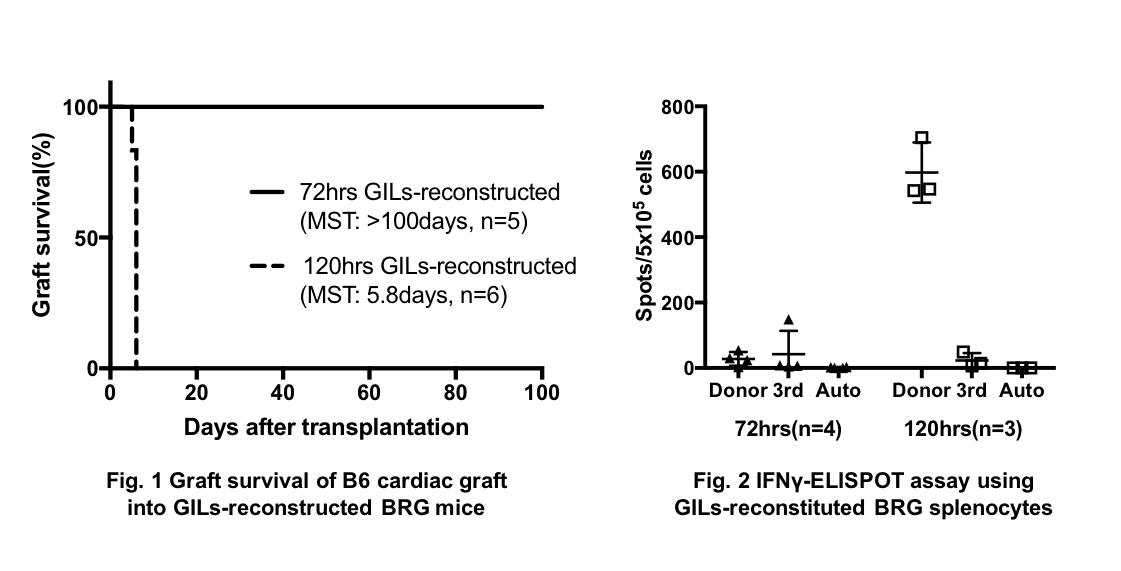The Impact of Biological Behavior of Allograft Infiltrating Lymphocytes during Early Phase
Y. Ganchiku, R. Goto, R. Igarashi, R. Kanazawa, K. Shibuya, Y. Fukasaku, N. Kawamura, M. Zaistu, M. Watanabe, M. Fukai, A. Taketomi
Gastroenterological Surgery I, Hokkaido University, Sapporo, Japan
Meeting: 2019 American Transplant Congress
Abstract number: A29
Keywords: Allorecognition, Graft-infiltrating lymphocytes, T cell reactivity
Session Information
Session Name: Poster Session A: Antigen Presentation / Allorecognition / Dendritic Cells
Session Type: Poster Session
Date: Saturday, June 1, 2019
Session Time: 5:30pm-7:30pm
 Presentation Time: 5:30pm-7:30pm
Presentation Time: 5:30pm-7:30pm
Location: Hall C & D
*Purpose: The graft infiltrating lymphocytes (GILs) build an immunological microenvironment locally. Reportedly the GILs within 72hrs posttransplantation do not attack allograft, but may prevent from rejection (Goto R, AJT 2012). To understand the precise roles of GILs during early phase, we examined the alloreactivities of GILs in its time course by using immunodeficient mice.
*Methods: B6 (H2Kb) cardiac allografts were transplanted into Balb/c (H2Kd) mice. Balb/c Rag2-/- γc-/-(BRG) micewere applied for immunodeficient mice.
*Results: The almost all CD3+lymphocytes in the cardiac allograft (96.5±1.2%, n=4) at 72hrs posttransplant were expressed on H2Kdsuggesting that majority of GILs was already attained from the recipient’s immunity until 72hrs. A few GILs at 72hrs were dramatically increased to greater than 3 times until 120hrs (1.6±0.2×105to 5.2±0.6×105, n=9-11, p<0.001). A significant increase of IFNγ, perforin, granzyme B-producing CD8+ T cells, T-bet+, CD25+Foxp3–and Fox3+CD4+T cells of GILs was observed from 72 to 120hrs (IFNγ: 6.9±0.8 to 30.0±2.7%, Perforin: 3.5±1.7 to 27.3±3.7% , Granzyme B: 7.6±1.1 to 37.7±5.9% among CD8+, T-bet+: 31.6±5.3 to 63.2±3.7%, CD25+Foxp3–: 10.1±4.6 to 29.3±6.9%, CD25+Foxp3+: 12.0±2.2 to 27.1±8.3% among CD4+, n=4-7, p<0.004, respectively). It suggested that the GILs was noticeably changed between 72 and 120hrs. Next, to analyze the biological behavior, GILs from the cardiac allografts 72 and 120hrs posttransplantation (B6 to Balb/c) were reconstituted into immunodeficient BRG mice. At 10 weeks after injection of GILs, B6 cardiac allografts were transplanted into GIL-reconstituted BRG-mice. Of interest, B6 allografts were rapidly rejected in the mice which were reconstituted by the GILs from 120hrs, although the mice reconstituted by 72hrs GILs accepted the allograft in long-term (Fig 1). Consistently the IFNγ-ELIspot assay revealed that only 120hrs GILs reconstituted BRG mice responded donor antigens (Fig 2). Furthermore, when the cardiac allografts procured at 72hrs were re-transplanted into BRG mice, the allograft kept well-beating long-term (>100days, n=4).
*Conclusions: We made obvious the differences of phenotype and function of GILs in early phase depending on the timing: 120hrs but not 72hrs GILs have the capability of participating in alloimmune responses. The earlier GILs may permit the allograft acceptance.
To cite this abstract in AMA style:
Ganchiku Y, Goto R, Igarashi R, Kanazawa R, Shibuya K, Fukasaku Y, Kawamura N, Zaistu M, Watanabe M, Fukai M, Taketomi A. The Impact of Biological Behavior of Allograft Infiltrating Lymphocytes during Early Phase [abstract]. Am J Transplant. 2019; 19 (suppl 3). https://atcmeetingabstracts.com/abstract/the-impact-of-biological-behavior-of-allograft-infiltrating-lymphocytes-during-early-phase/. Accessed December 14, 2025.« Back to 2019 American Transplant Congress

